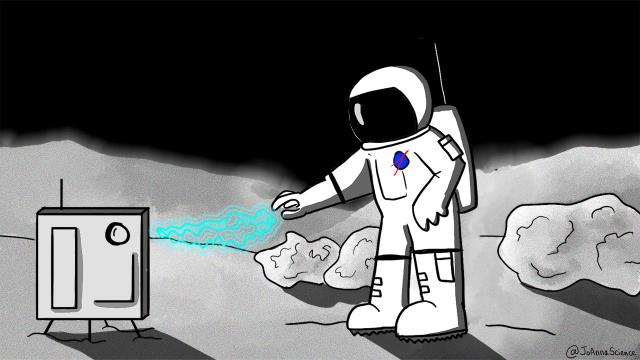Imagine you’re an astronaut, gazing out over the Moon’s icy grey surface. You’re on a field assignment, checking some instruments, and as you trudge toward a lunar dust detector, you notice how twinkly the stars seem, and you just can’t believe you’re on the MOON, and you’re doing SCIENCE and—
ZAP! A spark flashes on your outstretched hand, and your spacesuit sizzles. You check for damage, to your suit and to the instrument. Luckily, everything seems in order. That was a close one.
Although this particular scenario is entirely hypothetical, some scientists worry that the Moon’s charged and dusty surface could spark on instruments or spacesuits, similar to how you might get shocked by touching a doorknob after walking across a carpeted floor—except on the Moon, there’d be no actual contact required.
The Moon’s surface carries an electric charge because it’s exposed to the solar wind, streams of charged particles—negatively charged electrons and positively charged ions—constantly spewing from the Sun. Earth’s magnetic field protects us from these highly charged particles, but the Moon lacks a magnetic field. These free-flowing electrons and ions cause the Moon’s surface to become charged.
Along with the charge, there’s also the dust that makes up the top layer of the Moon’s surface. This dust gets everywhere, and it’s jagged and abrasive. On a spacesuit, dust can act as pathway for the flow of electrons, which could lead to an electric shock, according to Joseph Wang, a plasma physicist at the University of Southern California.
[referenced url=” thumb=” title=” excerpt=”]
When we send humans back to the Moon—either in 2024 or later—“the dust will always be sticking to every surface,” Wang said. It doesn’t matter what you do, “the lunar dust will stick.”
Wang and his colleagues wanted to find out whether lunar dust could increase the chances that future astronauts on the Moon get shocked. Of course, humans have already walked on the Moon and stayed there for days at a time, over multiple missions, during the Apollo program. Those astronauts never reported issues with electric shocks, on their equipment or persons, according to Jim Rice, a senior scientist at the Planetary Science Institute in Arizona.
But Wang said that’s because the Apollo missions operated in regions where, during the day, they were bathed in sunlight.
Sunlight itself doesn’t carry a charge, but photons hitting the Moon’s surface can kick up electrons in a process known as photoelectric emission. Those departing electrons leave behind a more positively charged surface, which balances out the negative charges brought along by the solar wind’s electrons. With the two charges more balanced, shocks are less likely.
But NASA wants to land humans on the Moon’s south pole, where the sunlight hits at a low angle and permanently shadowed regions hold water ice. In these areas, the electrons of the solar wind dominate, and there’s little sunlight to positively charge the surface. According to Wang, who presented his team’s research at the annual American Geophysical Meeting in San Francisco, shadowed regions on the Moon build up large negative charges—“hundreds to thousands volts negative,” according to the abstract.
Rice doesn’t think astronaut electrocution should be a huge concern, based on astronauts’ past experiences on the Moon. However, he conceded that we don’t know what would happen if, in the future, astronauts are moving charged material around with lunar bulldozers or other equipment.
To test whether spacesuits might contribute to electric shocks on the Moon, Wang and his colleagues placed samples of Gore-Tex (a fabric used in spacesuits) into vacuum chambers with a lunar soil simulant that closely mimicked the chemical makeup of lunar regolith. Some of the samples were covered in dust, while others were clean. The team then blasted the samples with plasma to see which samples would be vulnerable to electrical arcing.
As Wang suspected, the dusty Gore-Tex samples experienced arcing more often than the clean samples, because the soil particles disrupted the uniform surface of the spacesuit. Such disruptions can allow electrons to discharge. Imagine a ski slope: A smooth slope would allow skiers to whiz down the slope without disruption. But introduce bumps on that slope, like dust on a spacesuit, and it’s more likely that skiers might hit those and get some air.
What does this mean for future astronauts? Wang isn’t certain. “We demonstrated that arcing can occur on spacesuit material in a simulated lunar surface in a plasma environment,” he said. “The next question is: Can arcing cause damage to the spacesuit?” Whether these shocks could damage crucial equipment or even the astronauts themselves are further questions to be answered.
JoAnna Wendel is a science cartoonist and writer in Washington, DC. She loves space, planets, rocks, and her cat, Pancake. You can find her work at joannawendelcomics.com@JoAnnaScience.
